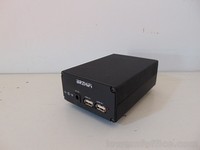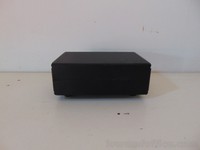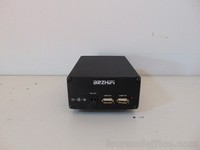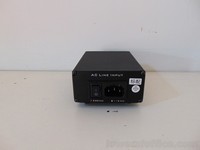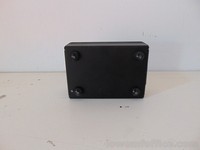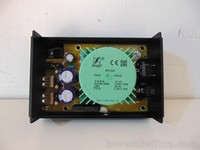Review of a linear power supply
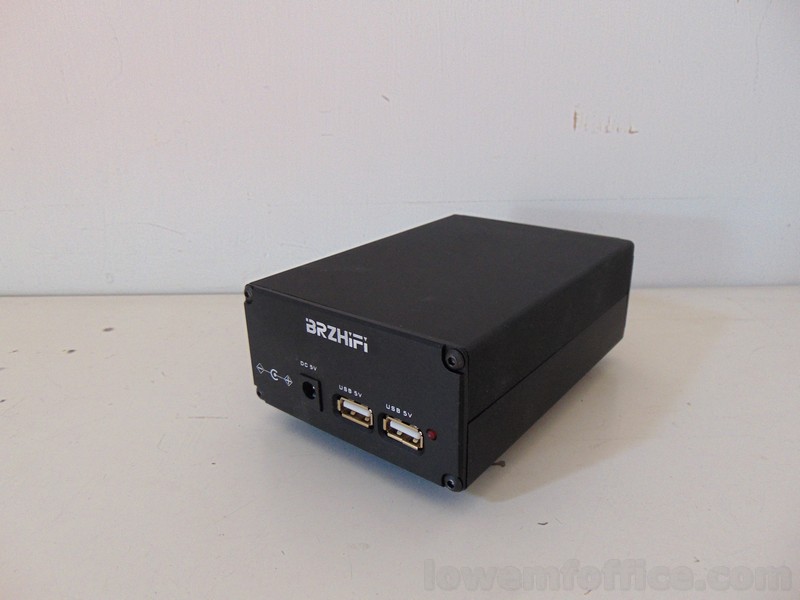
Introduction
This is a linear power supply available on the Aliexpress online shop. It is clearly a linear power supply, it contains a toroidal transformer, a rectifier bridge, a few electrolytic capacitors, and an integrated voltage regulator, so we can be sure that it doesn't generate any electromagnetic noise of the medium and high frequencies, at least not on purpose. The number and size of electrolytic capacitors is not large so the ripple may be noticeable when the output current is close to the maximum. The integrated voltage regulator is mounted on the metal enclosure of the power supply so the metal enclosure works also as a large heat sink. The small capacitors in front of the exits are needed to prevent resonances with the load. The enclosure is made of an aluminum alloy so it doesn't absorb the magnetic field of the transformer, it would be better if the enclosure was made of mild steel. We used a digital oscilloscope which has a bandwidth of 200 MHz to check the output voltage when the power supply is attached to a LED desk lamp which absorbs about 3 A of current. The digital oscilloscope calculated a voltage amplitude of about 160 mV peak to peak. We did the same test with one of our linear power supplies, in the same conditions, and the digital oscilloscope calculated the same voltage amplitude of 160 mV peak to peak.
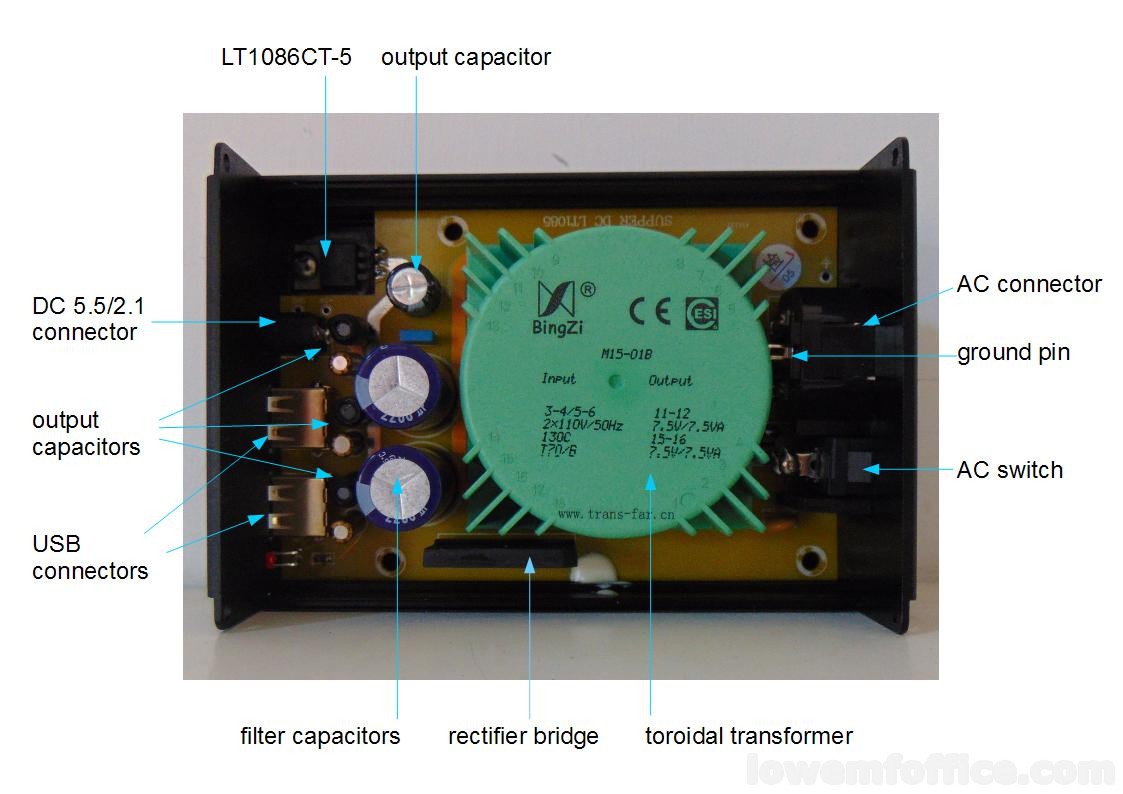
Dimensions
Length: 13 cm
Width: 9 cm
Height: 5 cm (including feet)
Input voltage
The input voltage has to be selected at the moment of the purchase because it cannot be changed. It can be either 115 V AC for USA and Canada, or 230 V AC for Europe and Australia.
Integrated voltage regulator
The integrated voltage regulator is the LT1086CT-5 by Linear Technology. It is a low-dropout voltage regulator, which means that the voltage difference between the input and the output is relatively small, compared to other voltage regulators. Since the voltage drop is small, the power lost into the circuit is lower, and so the circuit can support a higher current. The datasheet of this circuit says that the maximum current is 1.5 A instead this power supply is sold as a 15 W power supply which means that it can provide up to 3 A, so the manufacturers decided that the component LT1086CT-5 could be used also up to 3 A. The regulator is mounted on the floor of the metal enclosure so it has a very large heat sink, the heat will spread to the entire metal enclosure.
Grounding
The ground contact of the AC input connector of this product is not soldered to anything. Some people say that the metal enclosure of the power supply should be connected to the ground wire. However if the connection is made on the inside of the box it might not work against radio frequency noise that come into the box through the AC input. Some people suggest to attach a ground wire to the exterior of the enclosure. For example we can partially unscrew one of the screws and wind a copper thread around the screw, and then tighten the screw again. This copper thread then has to be attached to the ground wire of the AC power cable. Another way would be to drill a small hole on the back of the enclosure and fix the ground wire to the enclosure by means of a screw or a piece of metal especially made for grounding. We haven't tried to do this as our impression is that the power supply is good enough, besides the low frequency magnetic field.
Ripple
There are just two 2200 uF electrolytic capacitors so the total capacitance
before the regulator is just 4400 uF.
When the output current is 3 A, at the input frequency of 50 Hz, the ripple
before the regulator would be:
 which is excessive of course, given that the output voltage must be 5 V DC.
The output voltage of the transformer, according to the transformer label,
is 7.5 V AC which means that the output peak voltage is 7.5 * 1.4142 = 10.6 V.
Then there is the voltage loss on the rectifier bridge. Since this is a diode
bridge there are always two diodes in series conducting, so the voltage loss is
double the voltage loss of a diode. Assuming the the voltage loss of a diode is
0.6 V then the voltage loss of the bridge is 1.2 V.
So the peak voltage before the capacitors, and before the regulator, is
10.6 - 1.2 = 9.4 V.
So the minimum voltage before the regulator is 9.4 - 6.8 = 2.6 V which is
probably enough for keeping the regulator in the working zone.
The regulator reduces the ripple.
According to the measurement done with a digital oscilloscope, under the maximum
load the output ripple is about 160 mV.
which is excessive of course, given that the output voltage must be 5 V DC.
The output voltage of the transformer, according to the transformer label,
is 7.5 V AC which means that the output peak voltage is 7.5 * 1.4142 = 10.6 V.
Then there is the voltage loss on the rectifier bridge. Since this is a diode
bridge there are always two diodes in series conducting, so the voltage loss is
double the voltage loss of a diode. Assuming the the voltage loss of a diode is
0.6 V then the voltage loss of the bridge is 1.2 V.
So the peak voltage before the capacitors, and before the regulator, is
10.6 - 1.2 = 9.4 V.
So the minimum voltage before the regulator is 9.4 - 6.8 = 2.6 V which is
probably enough for keeping the regulator in the working zone.
The regulator reduces the ripple.
According to the measurement done with a digital oscilloscope, under the maximum
load the output ripple is about 160 mV.
Comparison with our own linear power supplies
Our own linear power supplies have a steel enclosure which reduces the magnetic field at the low frequency aroud the box. Also our power supplies contain an AC filter, which has some positive effect on the high frequency EM noise coming from the AC cable. Probably the quality of the toroidal transformer of our power supply is better than the quality of the transformer included in this product. The integrated voltage regulator that we use is the LM1084 series, which is more or less equal to the LT1086. Our power supplies contain much more capacitance after the rectifier, so the ripple is much smaller even before the regulator.
Conclusion
In conclusion we think that this product is good enough to be used in a low EMF office, but only being careful about the position and placement of the box and the cables. If the enclosure was made of mild steel this product would be much better.
